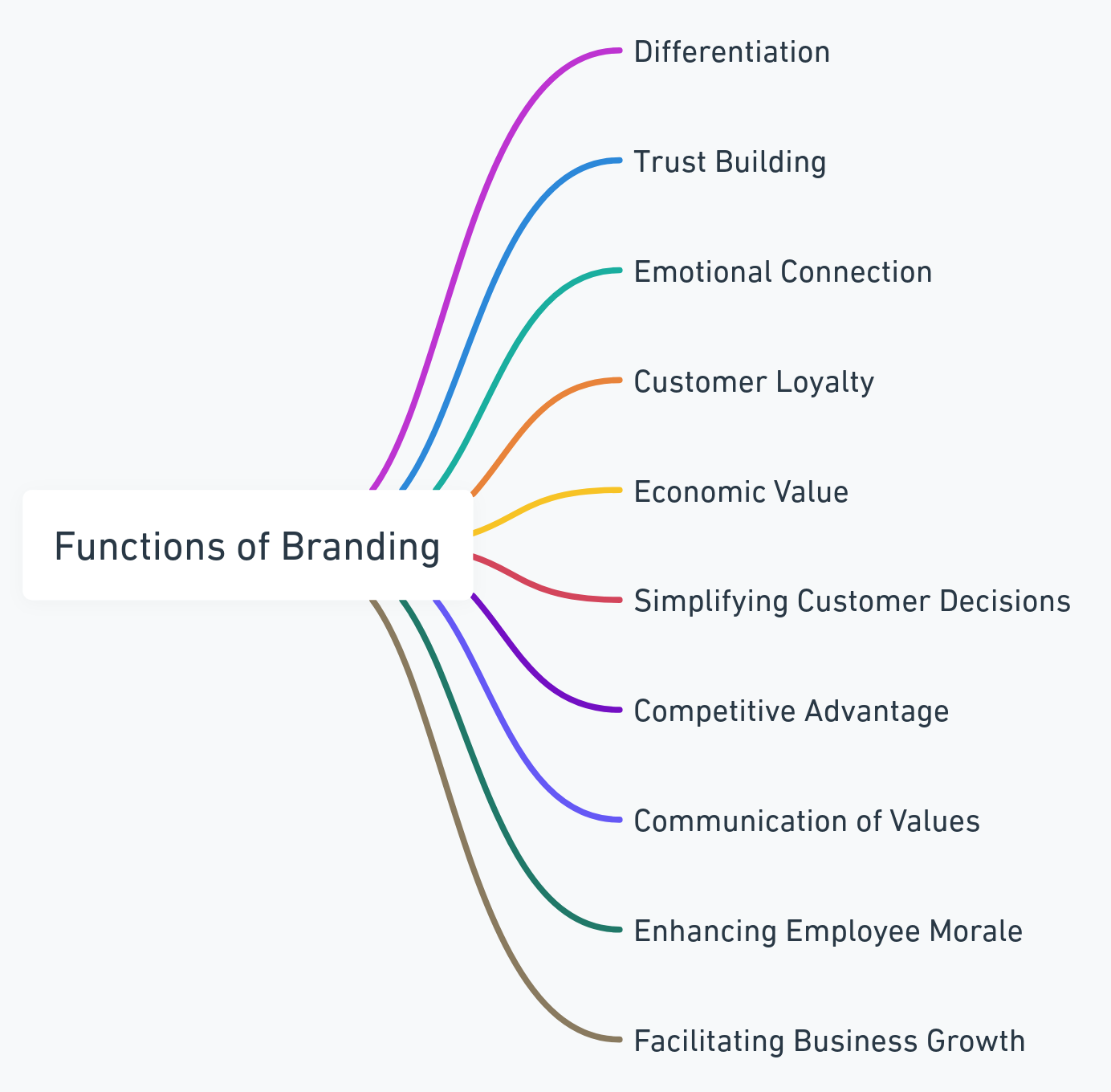Branding plays an important role in distinguishing businesses in the present competitive world. An effective branding strategy increases customer perceptions and opens avenues for long-term business success. Branding gives businesses a unique voice that can convey their values. The major Functions of branding is that it includes more than mere recognition; it also includes building trust, gaining the loyalty among customers, and creating an identity in the market . It equips companies with the tools to stay relevant and adapt to market trends, thereby ensuring long-term visibility and influence. A good brand identity develops emotional connections with customers, turning occasional buyers into loyal advocates who share the same ethos as the brand.
What is a Brand?
A brand is an identity of a business as well as a public face. On the other hand, this would influence its perception of customers and competitors. Though founded upon tangible elements, like a logo or the products of a firm, yet more so by intangible elements: reputation, and the emotional attachment it commands. A brand that feels this would evoke loyalty from people with it. The business stands out in the already saturated marketplace. Brands add value to an organization, fine-tuning it to its objectives with customers’ desires. At some point in time, a brand may become synonymous with trust, perfection, and innovativeness; hence, building a stronger position in the market.
Features of Branding in Marketing
- Name and Logo: It should have a name that gives an impression at first, while a logo gives a visual view to prove quick recall and recognition. If positive, it may become iconical like golden arches from McDonald’s or Nike’s swoosh.
- Brand Promise: Promise to deliver specific value that creates reliance and sets consumer expectations. If kept well, the promise strengthened trust and eventually long-term relationships.
- Customer Experience: Every interaction shapes how customers perceive a brand. Positive experiences, from website navigation to customer support, foster loyalty, and advocacy.
- Brand Story: A compelling narrative gives a brand purpose and humanizes it, connecting with audiences emotionally. The story often reflects the company’s mission and values.
- Consistency: Aligning all brand elements ensures clarity and strengthens customer recognition across different channels and touchpoints.
Define Branding in Marketing
Branding in the marketing process defines a unified or unique identity so that it may align with the needs of people. It is not by advertising itself, but through communications and interactions towards customers that the objective of the company gets fulfilled. There’s a real possibility of business values getting placed in line with customer needs at the right stages, hence creating emotional and practical tie-ups. Branding helps a business connect the customer with topics of trust and loyalty, encouraging repeat purchases alongside word of mouth. Continuous branding over time causes the company to become an efficient competitor in the market, which makes it an industry leader.
Functions of Branding
The basis of the company’s existence in the marketplace is branding because it determines growth, differentiation, and loyalty between customers and their business. For this reason, 10 major functions of branding are listed with the explanation to define each one as of its importance for a company.

Differentiation
Specific quality or offerings and value propositions differentiate brands. For a business with so many of its competitors providing similar products in a crowded marketplace, a solid brand is recognized by customers to prefer over another brand. It could be by the quality or innovative nature of the superior service or perhaps by emotional attachment. For instance, Tesla will differ by pioneering electric vehicles as having the newest technology. This kind of positioning ensures that a business does not get lost in the crowd and grabs the eye of the potential market.
Building Trust
An established brand provides confidence to its customers as it delivers its promise every time. The trust comes into being when the brand remains trustworthy, transparent, and consistent across all points of contact. Such customers will more likely come back, recommend to others, and even pardon when the brand does something wrong once in a while. For instance, offerings trust with fast deliveries, and a wide array of product offerings, creating great customer care. Trust is a treasure very essential to creating long-lasting relations and repeat customers, hence making it easily a valuable asset for any brand.
Emotional Connection
It encompasses much more than the product; it goes to the emotive side, connecting the audience with the brand. This is primarily based on shared values or a memorable story. Targeting the needs and desires of customers also instills attachment. Companies such as Nike with “Just Do It” instill confidence and a never-give-up attitude among consumers. Emotionaing makes customers brand’s promoters because they will feel strongly to the brand on loyalty and active participation for continuous loyalty and action.
Customer Loyalty
Branding develops customer loyalty through repeat contact and expectations of customers. A strong brand is something that lets the customer feel valued and heard, and thus, he keeps coming back for more. Tools to enhance this bond are loyalty programs, personalized communication, and consistent quality. For example, Starbucks makes a customer feel that they belong through its loyalty rewards program and personalized cup writing. These loyal customers bring in recurring revenue but also act as brand ambassadors talking about the business through word-of-mouth.
Economic value
Brands add immense economic value to businesses as they heighten the business’s reputation in the market coupled with improved financial performance. For example, Apple or Coca-Cola brands can command high prices because of the value customers assign to their products. There is also the economic value of brand honesty where customers pay more for branded goods than generic ones. In addition, a well-branded company can attract better invelong-termartners, and the best talent, which further adds to the long-run profitability and success of the company.
Simplifying Customer Decisions
Branding simplifies choice by offering consumers a dependable choice in an ocean of choices. When there are many similar products, consumers prefer brands they can identify and are familiar with. For instance, most customers simply opt for Colgate in toothpaste buying decisions without much deliberation owing to its high brand equity and historical association with quality. Such a reduction in mental effort allows effortless buying, hence making branding an essential lever to influence the choice of purchase.
Competitive Advantage
Branding gives businesses a sustained competitive advantage because it allows businesses to create identity and loyalty from customers. A well-developed brand is differentiated not only by the offer but also in terms of the experience and emotional appeal that it can provide for the customer. For example, BMW branded itself as a luxury automobile manufacturer, driven by performance; hence it was the leader in the premium market segment. Such competitive advantage means that the brand remains a preferred choice even in highly competitive industries.
Communication of Values
Brands are a medium through which a business can communicate its mission, vision, and values to its audience. This communication makes the customers relate to the brand on a deeper level, leading to trust and loyalty. For example, Patagonia can communicate sustainability and environmental activism in its commitment through branding. The clear value means that the brand will attract people with the same belief, making for a more energized and activated customer base.
Boosting Employee Morale
A strong brand is a great brand for the external stakeholders but also for internal employees. Employees feel proud to be part of great brands, and this helps improve their morale and productivity. The company’s ability to brand itself as innovative and inclusive can give an environment for employees to get inspired and create something creative at work. Attracting talent is also very easy if a company can project the workplace as the most desirable destination, further reinforcing its competitive edge.
Supporting Business Growth
Branding is what creates a foundation for long-term growth through the establishment of a cohesive, recognizable identity. A well-developed brand facilitates entry into new markets or launching new products since established brands are more trusted. For instance, Amazon Fresh, where Amazon ventured into grocery sales, relied on the brand credibility of Amazon to accept the market. Sustained growth for businesses happens through scaling while keeping their core identity intact due to effective branding.
Nature of Branding
Branding reflects its dynamic, multifaceted role in the formulation of business strategies and consumer perception. Branding is strategic; it aligns with a company’s long-term goals and defines its direction. It shapes consumer psychology and forms value perception in consumers as they develop preferences for one brand over another. Branding is not static; it evolves with the changes in society, technological development, and consumer expectations. It also reveals the personality of a company by incorporating visual aesthetics, a unique identity to bring into being a unique brand. Branding, at heart, means uniformity; every encounter-from advertising to customer service strengthens the values of the brand. This dynamic makes branding always relevant for businesses wanting to build enduring relationships with audiences.
Function of Branding FAQs
What is brand equity in marketing?
Brand equity is the value a brand contributes to a product or service. It represents the consumer’s perceptions, loyalty, and trust in the brand. It often reflects in monetary advantages such as higher prices and volume sales.
What are the functions of branding to customers?
For the customer, it gives assurance regarding quality, facilitates easier decision-making, and encourages emotional bonding for a more rewarding and dependable experience while shopping.
How does branding help the business?
Branding helps businesses stand out, increase customer loyalty, and appreciate their market value, ensuring long-term success.
Can small businesses make effective use of branding?
Yes, for instance, small businesses can effectively use branding to carve out an identity, connect with local audiences, and compete with larger players by extolling authenticity and community engagement.
What is primarily brand management?
Brand management is about preserving and enriching the value of a brand by maintaining constant communication and quality assurance in relation to marketing efforts.


